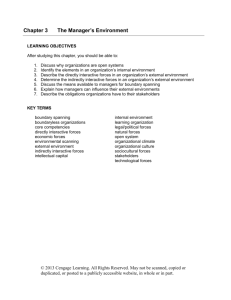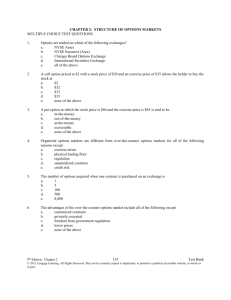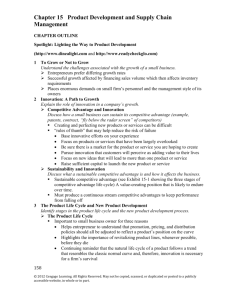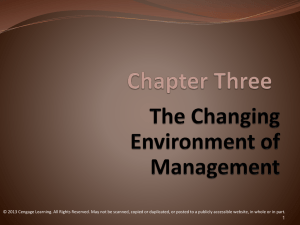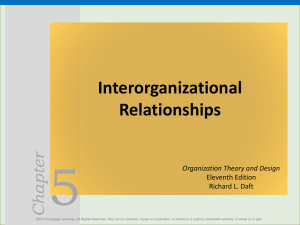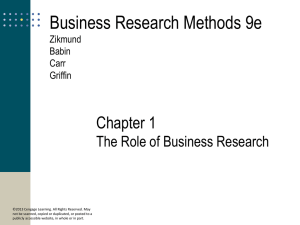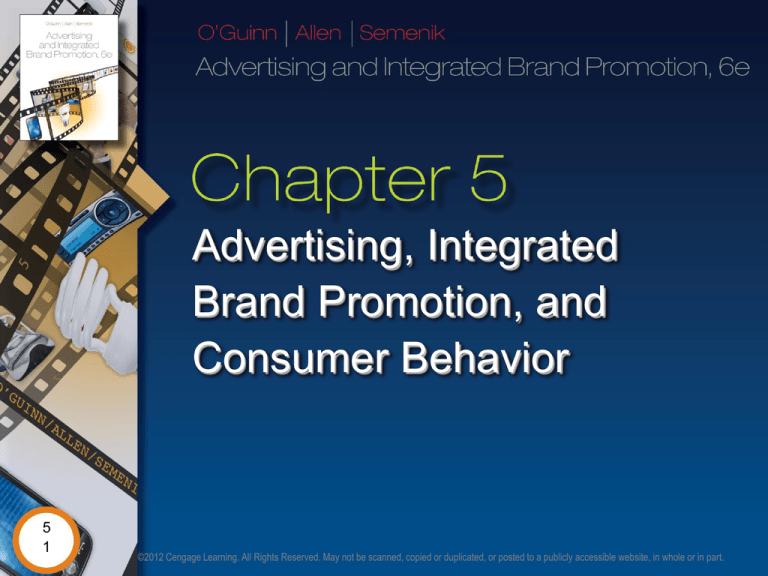
Advertising, Integrated
Brand Promotion, and
Consumer Behavior
5
3
1
1
©2012
©2012
Cengage
Cengage
Learning.
Learning.
All Rights
All Rights
Reserved.
Reserved.
MayMay
not not
be scanned,
be scanned,
copied
copied
or duplicated,
or duplicated,
or posted
or posted
to atopublicly
a publicly
accessible
accessible
website,
website,
in whole
in whole
or inorpart.
in part.
Consumer Behavior
Consumer Behavior: a wide spectrum of things
that affect, derive from, or form the context of
human consumption
Perspectives:
5
3
2
•Consumers are Systematic Decision Makers
o They process information
o They seek to maximize benefits from
purchases
o They are deliberate
•Consumers are Social Beings
o Cultural/social membership defines purchases
o They are “meaning makers” in their
consumption
©2012 Cengage Learning. All Rights Reserved. May not be scanned, copied or duplicated, or posted to a publicly accessible website, in whole or in part.
Perspective One: The Consumer as
a Decision Maker
The Consumer is:
• Logical
• Purposeful
• Acts in a “sequential” manner in
making decisions
5
4
3
©2012 Cengage Learning. All Rights Reserved. May not be scanned, copied or duplicated, or posted to a publicly accessible website, in whole or in part.
The Consumer Decision-Making Process
1. Need recognition
•
•
•
Need state: desired vs. actual state
Maslow’s hierarchical structure as
a perspective
Functional or Emotional benefits
•
•
•
Internal and External search
Consideration Set
Evaluative Criteria
Courtesy, Lowe’s
2. Information Search and
Alternative Evaluation
Is this a
functional or
emotional appeal?
3. Purchase
4. Post-purchase use and evaluation
5
5
4
•
•
Customer satisfaction
Cognitive dissonance
©2012 Cengage Learning. All Rights Reserved. May not be scanned, copied or duplicated, or posted to a publicly accessible website, in whole or in part.
Cognitive Dissonance
The feelings of doubt and concern after
a purchase is made. Dissonance
increases when:
•The purchase price is high
•There are many close alternatives
•The item is intangible (example?)
•The purchase is important
•The item purchased lasts a long time
5
6
5
©2012 Cengage Learning. All Rights Reserved. May not be scanned, copied or duplicated, or posted to a publicly accessible website, in whole or in part.
When Dissonance is a Risk:
Reassure the Buyer
• Use Post-purchase contact
– Email, text message
• Great opportunity to communicate since the
buyer is in a state of heightened awareness
• Working to ensure satisfaction increases
brand loyalty
5
7
6
©2012 Cengage Learning. All Rights Reserved. May not be scanned, copied or duplicated, or posted to a publicly accessible website, in whole or in part.
Modes of Consumer
Decision-Making:
(Vary by involvement and experience)
Involvement: Relevance and Importance of a
Purchase
• Interests and avocations
• Risk—high price or long-term commitment
• High symbolic meaning to purchase
• Deep emotion attached to purchase
Experience
• More experience, more astute consumer
5
8
7
©2012 Cengage Learning. All Rights Reserved. May not be scanned, copied or duplicated, or posted to a publicly accessible website, in whole or in part.
4 Modes of Consumer
Decision Making:
(Vary by involvement and experience)
5
10
8
Extended Problem Solving: low experience, high involvement
• Deliberate, careful search
Limited Problem Solving: low experience, low involvement
• Common products, limited search
Habit or Variety Seeking: high experience, low involvement
• Variety seeking—switch brands at random
• Habit—buy single brand repeatedly
Brand Loyalty: high experience, high involvement
• Conscious commitment to find same brand each
time purchase is made
©2012 Cengage Learning. All Rights Reserved. May not be scanned, copied or duplicated, or posted to a publicly accessible website, in whole or in part.
Key Psychological
Processes in Advertising
Attitude
• Over overall evaluation of an object, person, or
issue on continuum = like/dislike; positive/negative
Brand Attitude
• Summary evaluations that reflect preferences for
various products and services
Salient Beliefs
• Small number of key beliefs. Five to nine salient
beliefs typically form the critical determinants of
attitude
5
11
9
©2012 Cengage Learning. All Rights Reserved. May not be scanned, copied or duplicated, or posted to a publicly accessible website, in whole or in part.
Key Psychological
Processes in Advertising
Multi-Attribute Models (MAAMs)
• Evaluative Criteria: attributes consumers use to
compare brands
• Importance Weights: priority assigned to
attributes
• Consideration Set: group of brands that are focal
point of decision effort
• Beliefs: knowledge and feelings consumer has
about various brands
5
12
10
©2012 Cengage Learning. All Rights Reserved. May not be scanned, copied or duplicated, or posted to a publicly accessible website, in whole or in part.
Key Psychological
Processes in Advertising
The Elaboration Likelihood Model (ELM)
• “Central route” persuasion when
involvement is high
• “Peripheral route” with peripheral cues
rather than strong arguments when
involvement is low
• Humor
• Imagery
• Jingles
5
14
11
©2012 Cengage Learning. All Rights Reserved. May not be scanned, copied or duplicated, or posted to a publicly accessible website, in whole or in part.
Perspective Two:
The Consumer as Social Being
• Perspective One: The consumer as a
decision maker can tell only part of
the story.
• Perspective Two: Consumption can
be a social and cultural process as
well.
• “Meaning” is more important than “attitudes”
5
16
12
©2012 Cengage Learning. All Rights Reserved. May not be scanned, copied or duplicated, or posted to a publicly accessible website, in whole or in part.
Consuming in the Real World
Values
Social
Class
Community
Rituals
Culture
Geo-Politics
5
18
13
Reference
Groups
Gender
(membership/aspiration)
Race/Ethnicity
©2012 Cengage Learning. All Rights Reserved. May not be scanned, copied or duplicated, or posted to a publicly accessible website, in whole or in part.
©Solaria/Shutterstock
Object
Meaning
Family
Five Sociological Factors in
Consumer Behavior and Advertising
Response
Stratification (Social Class) as a broad effect
– People within social strata live in similar ways, have similar views,
tend to consumer in similar ways
1. Family
– Intergeneration effect = habit
– Life stage effects
– Celebrity = identity
2. Race and Ethnicity
– A cultural effect
– Social identity
3. Politics
– Social disruption can effect consumer evaluations
4. Gender
– Socialization effects
– Evolving gender roles
5. Community
5
19
14
– Face-to-face, imagined or virtual
©2012 Cengage
Learning. All communities
Rights Reserved. May not be scanned, copied or duplicated, or posted to a publicly accessible website, in whole or in part.
– Brand
Factors Affecting
Consumer Decision Making
Values/Attitudes
Culture
Pleasure
©lev dolgachov/Shutterstock
Reference
Groups
Situational
Factors
Education
Personality
Needs
Gender
Marketing
Controlled Stimuli
Price, Packaging, Advertising
Promotion, Personal Selling
Media:
News, Magazines, Radio,
Television, Direct Media,
Blogs, Internet
Family
Social Class
5
23
15
Past
Experience Subcultures
Lifestyle
©2012 Cengage Learning. All Rights Reserved. May not be scanned, copied or duplicated, or posted to a publicly accessible website, in whole or in part.





